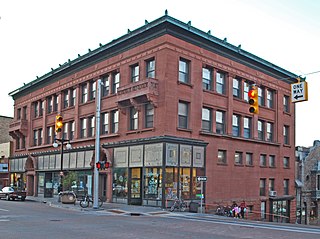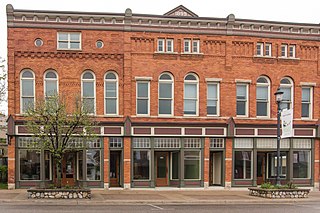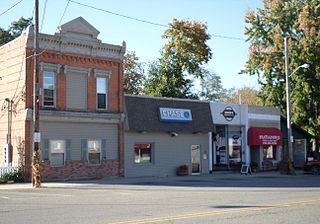
The Salem Maritime National Historic Site is a National Historic Site consisting of 12 historic structures, one replica tall-ship, and about 9 acres of land along the waterfront of Salem Harbor in Salem, Massachusetts, United States. Salem Maritime is the first National Historic Site established in the United States. It interprets the Triangle Trade during the colonial period, in cotton, rum, sugar and slaves; the actions of privateers during the American Revolution; and global maritime trade with the Far East, after independence. The National Park Service manages both the National Historic Site and a Regional Visitor Center in downtown Salem. The National Park Service (NPS) is an agency of the United States Department of the Interior.

The Sugar Hill Historic District is a historic district in Detroit, Michigan. It contains 14 structures located along three streets: East Forest, Garfield, and East Canfield, between Woodward Avenue on the west and John R. on the east. The district was listed on the National Register of Historic Places in 2003.

The Cass Park Historic District is a historic district in Midtown Detroit, Michigan, consisting of 25 buildings along the streets of Temple, Ledyard, and 2nd, surrounding Cass Park. It was listed on the National Register of Historic Places in 2005 and designated a city of Detroit historic district in 2016.

The Monroe Avenue Commercial Buildings, also known as the Monroe Block, is a historic district located along a block-and-a-half stretch at 16-118 Monroe Avenue in Detroit, Michigan, just off Woodward Avenue at the northern end of Campus Martius. The district was designated a Michigan State Historic Site in 1974 and listed on the National Register of Historic Places in 1975. The thirteen original buildings were built between 1852 and 1911 and ranged from two to five stories in height. The National Theatre, built in 1911, is the oldest surviving theatre in Detroit, a part of the city's original theatre district of the late 19th century, and the sole surviving structure from the original Monroe Avenue Commercial Buildings historic period.

The Victor Hotel is a historic hotel in the mining town of Victor, Colorado in the United States. The hotel is a four-story Victorian brick building built in 1899-1900 by the town's founders, the Woods brothers. It is on the National Register of Historic Places.

The Ault Store is a historic commercial building in Dundas, Minnesota, United States. The building was placed on the National Register of Historic Places (NRHP) on April 6, 1982.

The Shelden-Dee Block is a commercial building located on the corner of Shelden Avenue and Isle Royale Street in Houghton, Michigan. The building was listed on the National Register of Historic Places in 1980.

Fort Armstrong Hotel is a historic building located in downtown Rock Island, Illinois, United States. It was individually listed on the National Register of Historic Places in 1984. In 2020 it was included as a contributing property in the Downtown Rock Island Historic District. The hotel was named for Fort Armstrong, a fortification that sat in the middle of the Mississippi River near the present location of the Rock Island Arsenal. The building now serves as an apartment building.

Fifth Street Historic District is a national historic district located at Lynchburg, Virginia. The district encompasses 57 contributing buildings and 1 contributing object in a historically African-American section of Lynchburg. It includes a variety of residential, commercial, and institutional buildings, with about half dating to the period spanning from 1875 to 1940. Located in the district are the separately listed Kentucky Hotel, the Western Hotel, the William Phaup House, and the Pyramid Motors building. Other notable buildings include the Augustine Leftwich House, tobacco factories (1877-1885), the Humbles Building (1915), M.R. Scott Meat Market (1919), Miller Tire and Battery Company (1927), Adams Motor Company building (1927), Hoskins Pontiac (1951), Burnett Tire Company (1956), Moser Furniture Company building (1936), Fifth Street Baptist Church (1929), Community Funeral Home (1922), and Tal-Fred Apartments (1940).

The Alma Downtown Historic District is a commercial historic district in Alma, Michigan, roughly located along Superior Street between the Pine River and Prospect Avenue, and along State Street between Center and Downie Streets. Parts of the district were designated a Michigan State Historic Site in 1975, and the entirety was listed on the National Register of Historic Places in 2013. It contains 72 structures, primarily brick commercial buildings, ranging from one to three stories in height and dating from 1874 to the 1960s.

The Urbana-Lincoln Hotel – Lincoln Square Mall is a historic building complex located at 300 South Broadway Avenue in Urbana, Illinois. The Tudor Revival style hotel was built in 1923. In 1964, the mall was built as an extension of the hotel; it was one of the first fully enclosed shopping malls in Illinois. The hotel, the mall, and the building complex was listed on the National Register of Historic Places in 2006. As of October 2017, the mall was still in operation, however the hotel was closed.

The New Center Commercial Historic District is a commercial historic district located on Woodward Avenue between Baltimore Street and Grand Boulevard in Detroit, Michigan. It was listed on the National Register of Historic Places in 2016.

The Hart Downtown Historic District is a commercial historic district located in Hart, Michigan along South State Street, and is roughly bounded by Main, Dryden, Water, and Lincoln Streets. It was listed on the National Register of Historic Places in 2015.

The East Jordan Lumber Company Store Building is a commercial building located at 104 Main Street in East Jordan, Michigan. It was listed in the National Register of Historic Places in 2008. It is next to, and shares a wall with, the Votruba Block; both buildings have been rehabilitated to form the Main Street Center office complex.

The Military Road Historic District is a commercial historic district located along Military Street and Huron Avenue, from Court Street to Bard Street, in Port Huron, Michigan. The district was listed on the National Register of Historic Places in 1998.

The Island City Historic District is a primarily commercial historic district which encompass the whole of the island on which stands the central part of Eaton Rapids, Michigan. It was listed on the National Register of Historic Places in 2012.

The Dibbleville-Fentonville Historic District is a primarily residential historic district roughly bounded by Shiawassee, Riggs, Holly and George Streets in Fenton, Michigan. It was listed on the National Register of Historic Places in 1982.

The Byron Historic Commercial District is a substantially commercial historic district, located in downtown Byron, Michigan, roughly along Saginaw Street from Maple Street to Water Street. The district was listed on the National Register of Historic Places in 1984.

The Adam C. Arnold Block was a commercial building located at 12-14 East State Street in Battle Creek, Michigan. It was listed on the National Register of Historic Places in 1983. It was demolished in 1988.

The Davenport Downtown Commercial Historic District is a nationally recognized historic district located in the central business district of Davenport, Iowa, United States. It was listed on the National Register of Historic Places in 2020. At the time of its nomination it consisted of 43 resources, which included 33 contributing buildings, one contributing structure, and nine non-contributing buildings. In addition, the district also contains 33 buildings that are individually listed on the National Register. This historic district is bordered by four other districts: the Crescent Warehouse Historic District and the Davenport Motor Row and Industrial Historic District on the east, the Hamburg Historic District to the northwest, and the West Third Street Historic District on the west.






















